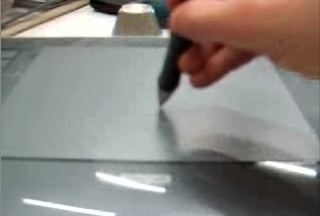The model necessitates the dynamical control of at least two parameters in order to be driven: bow speed and bow force. Additionaly, the position of the bow on the string and the pitch could be controlled as well. In the following example, the model is played using a WACOM tablet. The velocity is computed from the motion of the pen in one direction. The bow pressure is related to the pressing force of the pen on the surface, and the position of bowing on the string, to the perpendicular direction.

An interest of physical modelling consists in making possible to play with the different parameters and in producing this way some sounds that would not be so easy to obtain in the "real" world.
For instance, the string is defined by a set of parameters including its length, tension, density, Young modulus, damping coefficients, or friction coefficients. The length and the tension are mainly used to set the pitch of the string, whereas other parameters can be used to get more "exotic" sounds. Here are some examples of such a play with parameters.
The damping coefficients affects the decay time during the free vibration of the string.

|

|

|
| Normal damping | Low damping | High damping |
Young modulus is used to set the inharmonicity of the string.

|

|

|
| E=0 N/m2 | E=20e9 N/m2 | E=40e9 N/m2 |

|

|
| C4 sharp | A5 moll |

|

|
| Rather long contact time between the bow and the string. | Short contact time imitating a rebound with the bow stick. |

|

|
| Example 1 | Example 2 |

|

|

|
| "Classical" tremolo | Harsh tremolo, almost crushed on the string | Very light one, with low bow pressure |